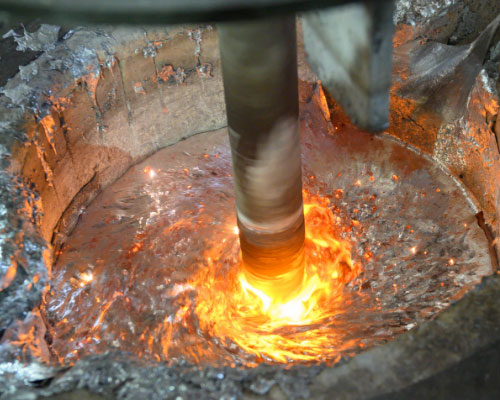Molten Aluminum is generally processed before casting for the removal of Hydrogen dissolved in the melt. This treatment is known as Degassing and Grain Refining.
Degassing and Grain Refining
Degassing is a common practice to reduce the Hydrogen gas content of molten Aluminum and its Alloys.
Among the earliest practices of degassing has been to treat the melt (molten Aluminum/Aluminum Alloy) with Hexa-chloro Ethane. Here-in, degassing is affected by Chlorine gas which emanates from the decomposition of the Hexa-chloro Ethane on its purging through the melt.
In order to improve the efficacy of removal of Hydrogen, as also for operational convenience and containment of environmental hazards; Online Degassing has been adopted by the industry.
In On-line Degassing, Nitrogen or an inert gas like Argon is purged through the melt with the help of specially designed rotating nozzles which enables the dissolved Hydrogen to come out of the melt as bubbles. Some such equipment available in the market for this purpose is SNIF, LARS, etc.
In the later developments, a small percentage of Chlorine has been added to the purging gas. This has helped in improving the efficacy of degassing process and thus has gained acceptance. However, the addition of Chlorine has its own complications and hazards in addition to the cost.
Grain refining of aluminum and its alloys is carried out for improving the microstructure of the cast product so as to improve the casting rate, resistance to hot cracking, and mechanical properties, particularly the toughness and ductility, etc.
Describing briefly the metallurgy behind grain refining, Gain Refiner when introduced into molten Aluminum and its Alloys; increases the number of sites available for the formation of grains. In such conditions, more grains are formed at the cost of the size of individual grains. Thus the microstructure of the material will have smaller/finer grains and hence better mechanical properties.

